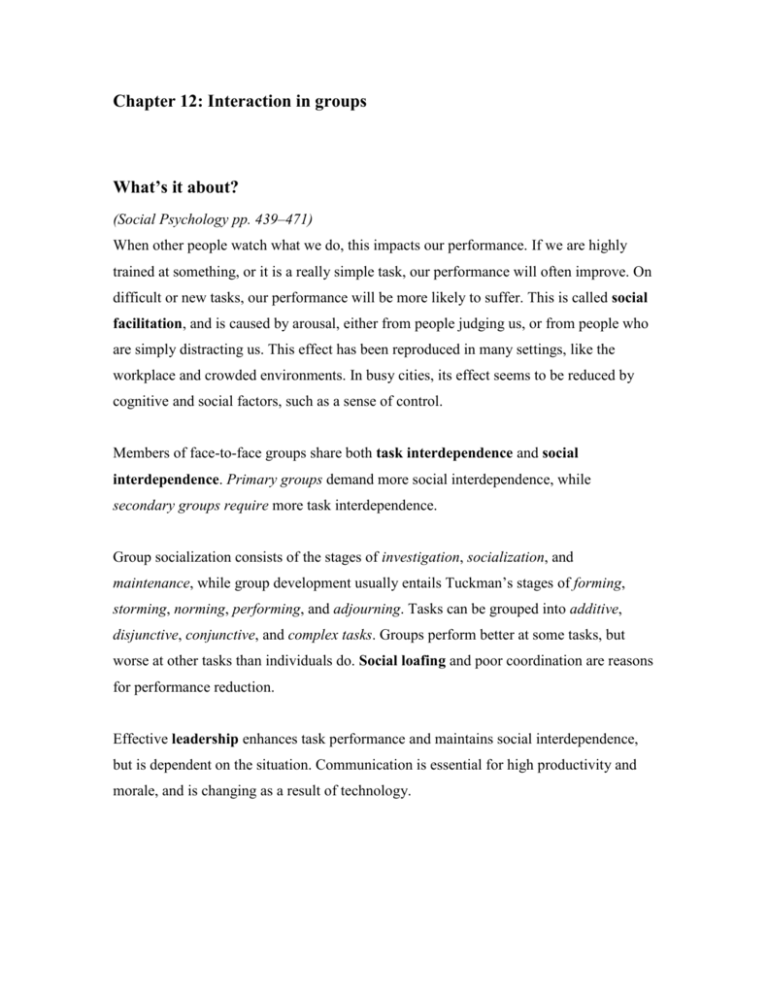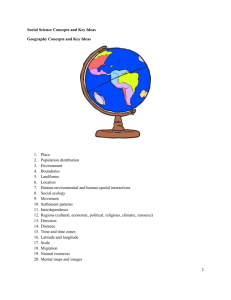Chapter 12 Interaction in Groups
advertisement

Chapter 12: Interaction in groups What’s it about? (Social Psychology pp. 439–471) When other people watch what we do, this impacts our performance. If we are highly trained at something, or it is a really simple task, our performance will often improve. On difficult or new tasks, our performance will be more likely to suffer. This is called social facilitation, and is caused by arousal, either from people judging us, or from people who are simply distracting us. This effect has been reproduced in many settings, like the workplace and crowded environments. In busy cities, its effect seems to be reduced by cognitive and social factors, such as a sense of control. Members of face-to-face groups share both task interdependence and social interdependence. Primary groups demand more social interdependence, while secondary groups require more task interdependence. Group socialization consists of the stages of investigation, socialization, and maintenance, while group development usually entails Tuckman’s stages of forming, storming, norming, performing, and adjourning. Tasks can be grouped into additive, disjunctive, conjunctive, and complex tasks. Groups perform better at some tasks, but worse at other tasks than individuals do. Social loafing and poor coordination are reasons for performance reduction. Effective leadership enhances task performance and maintains social interdependence, but is dependent on the situation. Communication is essential for high productivity and morale, and is changing as a result of technology. Chapter topics The mere presence of others: The effects of minimal interdependence (SP pp. 440–445) Performance in face-to-face groups: Interaction and interdependence (SP pp. 445– 470) THE MERE PRESENCE OF OTHERS: THE EFFECTS OF MINIMAL INTERDEPENDENCE Ask yourself Did you ever fail at something you could do before, simply because someone was watching over your shoulder? Which tasks would you perform better with other people present, and which would suffer? When you are starting to learn something new, what is the effect of someone watching? What you need to know SOCIAL FACILITATION: IMPROVEMENT AND IMPAIRMENT (SP pp. 440–444) Explaining social facilitation Evaluation apprehension Distraction Social facilitation in the workplace: Monitoring and job performance CROWDING: THE PRESENCE OF LOTS OF OTHERS (SP pp. 444–445) Crowding and the urban environment Social Facilitation: Improvement and Impairment (SP pp. 440–444) Explaining social facilitation The mere presence of others can improve performance of simple well-learned tasks (dominant responses), but can interfere with the performance of complicated, difficult, or new tasks (nondominant responses). This effect is called social facilitation. RESEARCH ACTIVITY: Social facilitation [see ch12-RA-01.doc] Weblink: Try the effects out for yourself http://samiam.colorado.edu/~mcclella/expersim/introsocial.html In 1965, Robert Zajonc [DOI:10.1126/science.149.3681.269] claimed that social facilitation is caused by elevated arousal. His theory was supported by most subsequent research, which pointed to two underlying causes: evaluation apprehension and distraction. Evaluation apprehension When others are in a position to judge us, this produces evaluation apprehension (M. Rosenberg, 1969), which changes our performance as predicted by social facilitation. Nonjudging spectators do not cause such an effect. Distraction When others are present, they distract us from the task at hand, again influencing performance according to social facilitation. In these cases, arousal seems to stem from the difficulty of performing a task while reacting to others. This effect has also been demonstrated in nonhuman species. Social facilitation in the workplace: Monitoring and job performance In the workplace, employees are often monitored in a variety of ways. When employees know about this, social facilitation increases the productivity of highly skilled workers, but decreases the productivity of relatively unskilled workers (Aiello & Kolb, 1995 [DOI:10.1037/0021-9010.80.3.339]). Crowding: The Presence of Lots of Others (SP pp. 444–445) Crowding, the packing of many people into a space, causes arousal. This arousal can reduce contentment, increase aggression, and raise blood pressure. Its effects are again the same as predicted by social facilitation. Crowding and the urban environment Crowding does not have as much of a negative influence on people living in a crowded city as one might expect. Cognitive and social factors may aid in preventing such an influence. People with a sense of control seem to experience less stress than people without this sense. CASE STUDY: Crowding and the urban environment [see ch12-CS-01.doc] So what does this mean? When other people watch what we do, this impacts our performance. If we are highly trained at something, or it is a really simple task, our performance will often improve. On difficult or new tasks, our performance will be more likely to suffer. This is called social facilitation, and is caused by arousal, either from people judging us, or from people who are simply distracting us. This effect has been reproduced in many settings, like the workplace and crowded environments. In busy cities, its effect seems to be reduced by cognitive and social factors, such as a sense of control. PERFORMANCE IN FACE-TO-FACE GROUPS: INTERACTION AND INTERDEPENDENCE Ask yourself What kind of phases does a group normally go through? What makes some groups more effective than others? What does it take to be a good leader? What you need to know HOW GROUPS CHANGE: STAGES OF GROUP DEVELOPMENT (SP pp. 446–450) Group socialization: Becoming a member of the group Group development: Coming together, falling apart Time and group development GETTING THE JOB DONE: GROUP PERFORMANCE (SP pp. 450–458) Forms of task interdependence Gains and losses in group performance Losses from decreased motivation: Social loafing Losses from poor coordination Poor coordination in the workplace Cures for group performance losses LEADERSHIP (SP pp. 458–466) What do leaders do? Leadership effectiveness: Person or situation? Coaching leadership in youth sports Who becomes leader? Stereotypes and leadership Putting the group first: Transformational leadership The dark side of leadership GROUP COMMUNICATION (SP pp. 466–470) Mastery- and connectedness-focused communication Patterns of communication Technology and communication The computer as a group member Face-to-face groups such as family, organizations, teams, and others, are highly interdependent. These groups are socially interdependent because they need each other in order to feel part of a group, and to experience positive emotions such as respect, caring, and social identity. They are also task interdependent because material outcomes depend on their cooperation. Depending on their goals, groups demand different amounts of social or task interdependence. Primary or intimacy groups, such as families and close friends, demand more social interdependence, while secondary groups, such as organizations and teams, demand more task interdependence. Managing both forms of interdependence is difficult, but is necessary to achieve both mastery goals (high productivity) and connectedness goals (positive relationships). How Groups Change: Stages of Group Development (SP pp. 446–450) All groups go through different stages while trying to maximize task and social interdependence. This process consists of changing relationships between members and the group, in order for the group to get the job done. Group socialization: Becoming a member of the group Group socialization is a term used to describe the social changes a group goes through with individuals joining and leaving it (Moreland & Levine, 1988). This process of mutual evaluation and commitment goes through the following stages: The stage of investigation, in which groups seek members who will be useful to the group, and individuals look for groups that will satisfy their mastery and connectedness needs, unless groups are created by outside forces. Entry into the group triggers the socialization stage, in which groups and members try to shape each other to achieve their own goals. If this stage is successful, commitment will rise. When individuals are fully committed, the group enters the maintenance phase. In this phase, the group tries to find a role for members that will maximize their contribution, while members seek to maximize satisfaction. If this phase succeeds, mutual commitment remains high and members are likely to remain in the group. If it does not, members may (have to) leave the group unless corrective efforts are successful. This group socialization model makes it clear that groups don’t just change individuals, but individuals change groups as well. Group development: Coming together, falling apart Just as group members go through different stages related to their group, they go through different stages related to each other. Trying to coordinate task interdependence and enhance social interdependence, they may go through some or all of the following stages (Tuckman, 1965 [DOI:10.1037/h0022100]): Forming. Members try to see what the group stands for, and where other members stand. Members focus on the leader; that is, the member with the highest status, who is expected to state the group’s goals. Storming. The group tries to shape and negotiate roles, and decides on group goals and how to reach them. Conflicts may arise concerning these goals, but may also involve interpersonal issues. Conflict may be reduced when a majority are able to persuade the rest. Norming. If ever achieved, this stage involves a sense of unity and security, in which members are highly satisfied with the group, its purpose, and their role in it. Not surprisingly, group commitment is high. Performing. Members cooperate to solve problems, make decisions, and generate output in a climate of open communication and healthy disagreement, while remaining loyal to the group goals. Adjourning. This is the stage in which the group comes to an end. Groups end because they reach their goals, because they were only meant to exist that long, or because members decide not to be part of the group any more. In this stage, members often come together to evaluate the work done, give mutual feedback, and express their feelings. This stage can have quite an impact if group cohesion was high. Time and group development Besides the five stages mentioned above, other effects may occur as a result of the passing of time. Many groups take a while getting to know each other and making plans, only to find out time has passed without much progress being made. This was dubbed the “mid-life crisis” by Connie Gersick (1989) [DOI:10.2307/256363], because she found it often occurred about half way through the time given for the group. Others found that time pressure impacts the way groups approach their tasks. The greater the pressure, the more groups concentrate on task-focused matters and information sharing (Kelly, Jackson, & Hutson-Comeaux, 1997; Kelly & Karau, 1999 [DOI:10.1177/0146167299259002]; Kelly & Loving, 2004 [DOI:10.1016/S00221031(03)00094-5]). Although such groups are more productive, their work is often less creative and original (Karau & Kelly, 2004 [DOI:10.1016/0022-1031(92)90045-L]). Weblink: More about the basic nature of groups and how they develop http://www.managementhelp.org/grp_skll/theory/theory.htm Getting the Job Done: Group Performance (SP pp. 450–458) Ivan Steiner (1972) claimed that group tasks differ with regard to the required type of interdependence. Forms of task interdependence In additive tasks, the potential performance of a group is about equal to the sum of the individual members, so individual effort is important. If coordination fails, the results will not be as good. In disjunctive tasks, the potential performance of a group is as good as the best performance of one of its members. Education or training, or member selection, can improve group performance. If coordination fails, other members may get in the way of the best performing member. In conjunctive tasks, the group’s performance is as good as its weakest link. If coordination fails, the task will not be finished. Complex tasks contain subtasks that involve all forms of interdependence. The more complicated the task, the greater the need for planning, but the greater the opportunity to improve group performance compared to individual effort. RESEARCH ACTIVITY: Task interdependence [see ch12-RA-02.doc] Gains and losses in group performance Groups often perform better than individuals could through joint effort, varying skills, and the ability to perform multiple tasks at the same time, rather than one after the other. This enhanced performance can be witnessed in construction, puzzle solving, and surgical procedures. Collective memory is better than individual memory; groups provide more accurate and detailed accounts of events than single participants can. Frequently, however, working together results in a poorer result than if the same people were to work separately. People perform better at a brainstorming or memory task when working alone rather than when working as a group; they come up with more ideas that are of better quality in brainstorming sessions, and produce superior information in memory tasks. Groups sometimes display greater biases in judgment or decision-making tasks than individuals do. These losses in performance are often due to a reduction in motivation, or to poor coordination. Losses from decreased motivation: Social loafing Social loafing is the reduction of effort by people working in a group compared to when they work alone. It occurs in both simple motor tasks and cognitive tasks, such as brainstorming or attention tasks. Social loafing occurs less in interesting and involving tasks, and in tasks where individual contributions are essential for success. People are less likely to loaf when the group’s performance can be measured against a clear standard, and when members can be sure others are working hard as well. Strong identification with the group also decreases social loafing, which explains why women and people of interdependent cultures are less likely to loaf. People sometimes engage in social loafing because they believe that their group is more productive than it actually is, which is known as the “illusion of group productivity” (Paulus, Dzindolet, Poletes, & Camacho, 1993 [DOI:10.1177/0146167293191009]). Social loafing seems to depend on both task and social interdependence. When social loafing influences either task mastery or connectedness of the group, it declines. In some cases, social compensation occurs, in which one member works harder to compensate for other members’ weaknesses or lack of ability. Negative emotions of one member can influence the whole group. In such groups, conflicts can increase, cooperation can decrease, and members may (unjustly) believe task performance to suffer. Losses from poor coordination Organization is essential to the optimal success of a group. Members need to know what to do, what they and their fellow members are good at, how they influence the group’s performance, and who gives the orders. If any one of these factors is ignored, productivity may suffer as a result of tasks not being done, duplicated efforts, or getting in each other’s way. Even hearing other people speak may distract members from coming up with their own ideas or expressing them. Poor coordination in the workplace Poor coordination in groups can have devastating results, such as in flight cockpits and operating rooms. Lack of coordination, rather than lack of technical skills, seems to be the cause of error in such settings. Cures for group performance losses Making group membership a positive part of group members’ social identity is a successful strategy for reducing loss of motivation and failures of coordination. Organizations often try to achieve this by pushing forward the set of values, beliefs, understandings, and norms shared by members of the organization, known as the “corporate culture.” Corporate culture makes members feel good, and this social interdependence helps solve some of the problems of task interdependence. It encourages group cohesion, which, as Mullen and Copper (1994) [DOI:10.1037/0033-2909.115.2.210] found, increases group performance. CASE STUDY: Cures for group performance losses [see ch12-CS-02.doc] Cohesive groups encourage cooperation: Cohesive groups strive for group goals, instead of competing for individual ones. One way to promote group goals is by making personal rewards depend on group outcomes. This works: Cooperative group members like each other better, and learn more, and companies that emphasize teamwork rather than individual competition have higher performance records. Cohesive groups follow norms: People who feel they belong to a group will try to reach consensus about the group’s goals and the strategies necessary to achieve them. Members usually do what a cohesive group decides. If a cohesive group has high performance norms, its members will be highly productive. However, if such a group has low performance norms, productivity will suffer. If consensus is reached in a cohesive group, members won’t spend time discussing the norms. Norms aid group coordination, and help reduce motivation loss. Cohesive groups attract and keep valued members: Shared social identity reduces slacking or dropping out of members by boosting liking for the group, satisfaction with belonging, and morale. It can even help people cope with stress. Friendships and relationships between members, and higher esteem of ingroup members than out-group members, contribute to members staying in the group. Social identity can prevent members from leaving, even if rewards are lacking, or when they lose or fail at important tasks. Leadership (SP pp. 458–466) Leadership can be defined as a process in which one or more group members are allowed to influence and motivate other members to achieve group goals, and is crucial to the attainment of such goals. Leaders may be appointed, elected, or simply emerge from interaction. What do leaders do? Task-related leaders focus on decision making and task performance, while relationshiporiented leaders focus on enhancing cohesion and liking among group members. Both functions are vital to effective groups, and when combined they account for most of what leaders do (Mintzberg, 1980). Although leader behavior falls into the two earlier mentioned dimensions, one person may well be capable of fulfilling both roles. Leadership effectiveness: Person or situation? There’s been little success in identifying traits that make a successful leader. Socioemotional support consistently helps to improve morale, motivation, and job satisfaction. However, task-focused leader behavior is not as consistently related to improved task performance. Therefore, group success seems to depend on what kind of leader the situation demands. Contingency theories of leadership state that to maximize leadership effectiveness, the leader’s style should match the type of leadership demanded by the situation; a system called “matching.” Most complex tasks, however, require both leadership styles. Therefore, a good leader may be the one who has the flexibility to adjust the mix of social and task motivation a group requires. Coaching leadership in youth sports Coaches who gave positive feedback for good efforts as well as good performance, corrected mistakes with technique instruction, and emphasized fun and personal improvement, had children who enjoyed their athletic experiences and teammates most, and had the highest self-esteem. Their results as coaches did not suffer as a result of this behavior. Who becomes leader? Group members who talk a lot tend to be viewed as leaders, although the amount of talk does not reflect actual expertise. Other members assume talking to be a sign of competence or influence. Members also respond to nonverbal signs of dominance and assertiveness, like draping an arm around the adjacent chair, sitting at the head of a table, or sitting behind the microphone. Groups prefer leaders who embody the stereotypes, norms, or attributes typical for the group, and will view them as more effective. Another way to be deemed effective is through performing typical leader behaviors, such as emphasizing goals, and telling members what’s expected of them. In addition, group leaders who are close to the typical position on issues are also rated as more effective. Group members prefer and perform better for elected leaders who embody the group’s norms and goals, compared to appointed leaders who do not. Not surprisingly, the former are very effective leaders. Stereotypes and leadership Common stereotypes influence leadership. Group members who are male, taller, or older tend to be treated as leaders. Regardless of gender, people who look masculine are judged to be more competent leaders. Even when reminded of the possible effects of these stereotypes, people choose masculine-looking people as leaders, and rate them as more effective. The expectation that males make good leaders may serve as a self-fulfilling prophecy, explaining why the majority of the leaders in the world are male. Only when tasks require extensive social interaction do groups turn to women. Stereotypes also prevent ethnic minorities attaining leadership positions, which leads to underrepresentation in many types of business and government organizations. There are three related questions on this issue: (1) Who holds the group together? Women are much more effective than men at creating connectedness and cohesion. Groups and their members are happier when their boss is a woman. Women leaders show more concern for morale, and encourage members to participate in decision making. (2) Who gets the job done? Women are just as effective as men with regard to mastery and task performance. Women are slightly better leaders in business, educational, and government organizations, while men are slightly better leaders in the military. (3) Who do people believe make good leaders? Despite these objective measures, people regard male leaders as more effective than female leaders who behave in exactly the same way. This is probably caused by gender stereotypes. Putting the group first: Transformational leadership Charismatic or transformational leaders inspire extreme devotion and emotional identification by their followers, causing such leaders to have profound effects on their followers (Max Weber, 1921/1946). Such leaders can help followers reach their goals, or even redefine them, refocusing group members’ individual and personal goals to serve the community or the group. Followers pursue collective goals that go beyond self-interest, and are willing to make personal sacrifices for the collective good. Transformational leaders are self-confident, determined, skilled, and inspiring communicators. They take clear stands, focusing on commitment to goals, expressing optimistic visions of the future, and doubting old beliefs, and are very caring toward their group members. These leaders can bring about social organizational change when successful. Transformational leaders nurture cohesion among group members, and urge them to adopt the group’s goals. Group members look beyond themselves and take on the group’s goals, removing potential coordination and motivation losses. Because of this, transformational leaders are very effective, although the effect is greater in times of uncertainty and change. The dark side of leadership When leaders are bad, not only capital, but lives can be lost. Bad leaders can cause task motivation to disappear, and may cause group members to want to undermine their agenda and the group’s goals. Charismatic leaders can use their extraordinary influence over their followers in both positive as well as destructive ways. Weblink: More about the dark side of leadership http://www.govleaders.org/education_for_leadership2.htm Group Communication (SP pp. 466–470) Communication is the main weapon for groups to achieve high task efficiency while keeping cohesion in mind, which explains why so much time is spent talking about how to do the job. Mastery- and connectedness-focused communication Effective groups need a balance between task-focused and socioemotional communication in order to be effective, nurturing both task and social interdependence. Patterns of communication Communication networks are the patterns in which messages are sent in an organization. A centralized network has one person as the focus of all problem solving and decision making. This type of network is usually more effective for solving simple problems. A decentralized network has individuals communicating freely with each other. This type of network is usually more effective for solving complex problems. Instructions in a company are more often sent from the top down, while requests and information are more often sent from the bottom up. Bad news takes much longer to arrive at the top, sometimes resulting in disaster. A more informal way of communicating is via the “grapevine,” which is an informal network between individual members of the group, and which can be quite accurate. Technology and communication New technologies have considerable influence on the way tasks are completed, and how group members feel when they complete them (Hollingshead, 2004). Information sharing via video, e-mail, or instant messaging is often very efficient and to the point. Telephone calls and e-mails are good for completing simple tasks, because they focus on task-relevant features of the interaction. Computer-mediated group decision making may suffer less from problems like groupthink and biases that emphasize majority views. Electronically linked groups take longer to reach consensus, and make more unconventional decisions. High-status members usually dominate face-to-face interactions. When using technological communication, participation among members is more equal, but the difference re-emerges when status cues are displayed on computer software. Electronic group-related activities promote feelings about the group and its members’ place in it. Despite these advantages of technology, face-to-face communication still has its place. People who work in groups are happier and more satisfied than those working alone. Informal discussions in hallways and during coffee breaks are important sources of information. Face-to-face interaction seems to be essential for trust, commitment, and solidarity to grow among group members. For complex interpersonal problems, being able to read nonverbal cues is absolutely essential. The computer as a group member Instead of acting as a device for communication, computers can be used as partners in research, evaluation, and problem solving. Identifying a computer as a teammate strongly affects reactions to it, showing that computers are treated like fellow humans. People like such computers better, and see them as more helpful, with their contributions being more relevant. People change their own decisions more to comply with the computer’s suggestions when it is presented as a teammate. So what does this mean? Members of face-to-face groups share both task interdependence and social interdependence. Primary groups demand more social interdependence, while secondary groups require more task interdependence. Group socialization consists of the stages of investigation, socialization, and maintenance, while group development usually entails Tuckman’s stages of forming, storming, norming, performing, and adjourning. Tasks can be grouped into additive, disjunctive, conjunctive, and complex tasks. Groups perform better at some tasks, but worse at others. Social loafing and poor coordination are reasons for performance reduction. Effective leadership enhances task performance and maintains social interdependence, but is dependent on the situation. Communication is essential for high productivity and morale, and is changing as a result of technology.





